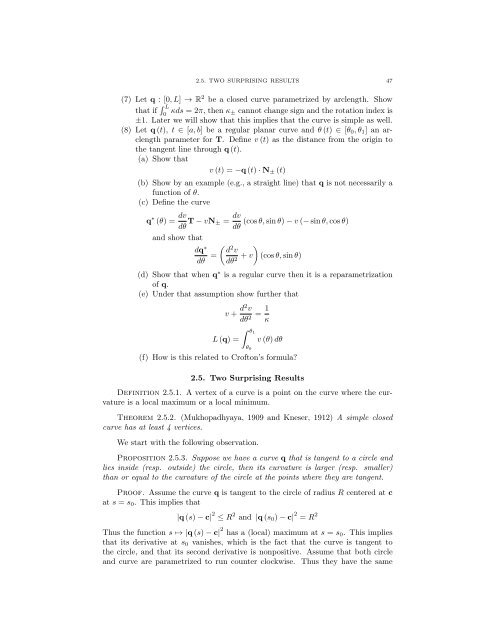Lecture Notes for 120 - UCLA Department of Mathematics
Lecture Notes for 120 - UCLA Department of Mathematics
Lecture Notes for 120 - UCLA Department of Mathematics
You also want an ePaper? Increase the reach of your titles
YUMPU automatically turns print PDFs into web optimized ePapers that Google loves.
2.5. TWO SURPRISING RESULTS 47<br />
(7) Let q :[0,L] ! R 2 be a closed curve parametrized by arclength. Show<br />
that if ´ L<br />
0 appleds =2⇡, thenapple ± cannot change sign and the rotation index is<br />
±1. Later we will show that this implies that the curve is simple as well.<br />
(8) Let q (t), t 2 [a, b] be a regular planar curve and ✓ (t) 2 [✓ 0 ,✓ 1 ] an arclength<br />
parameter <strong>for</strong> T. Define v (t) as the distance from the origin to<br />
the tangent line through q (t).<br />
(a) Show that<br />
v (t) = q (t) · N ± (t)<br />
(b) Show by an example (e.g., a straight line) that q is not necessarily a<br />
function <strong>of</strong> ✓.<br />
(c) Define the curve<br />
q ⇤ (✓) = dv<br />
d✓ T<br />
vN ± = dv (cos ✓, sin ✓) v ( sin ✓, cos ✓)<br />
d✓<br />
and show that<br />
dq ⇤ ✓ d 2 ◆<br />
d✓ = v<br />
d✓ 2 + v (cos ✓, sin ✓)<br />
(d) Show that when q ⇤ is a regular curve then it is a reparametrization<br />
<strong>of</strong> q.<br />
(e) Under that assumption show further that<br />
v + d2 v<br />
d✓ 2 = 1 apple<br />
L (q) =<br />
ˆ ✓1<br />
✓ 0<br />
v (✓) d✓<br />
(f) How is this related to Cr<strong>of</strong>ton’s <strong>for</strong>mula?<br />
2.5. Two Surprising Results<br />
Definition 2.5.1. A vertex <strong>of</strong> a curve is a point on the curve where the curvature<br />
is a local maximum or a local minimum.<br />
Theorem 2.5.2. (Mukhopadhyaya, 1909 and Kneser, 1912) A simple closed<br />
curve has at least 4 vertices.<br />
We start with the following observation.<br />
Proposition 2.5.3. Suppose we have a curve q that is tangent to a circle and<br />
lies inside (resp. outside) the circle, then its curvature is larger (resp. smaller)<br />
than or equal to the curvature <strong>of</strong> the circle at the points where they are tangent.<br />
Pro<strong>of</strong>. Assume the curve q is tangent to the circle <strong>of</strong> radius R centered at c<br />
at s = s 0 . This implies that<br />
|q (s) c| 2 apple R 2 and |q (s 0 ) c| 2 = R 2<br />
Thus the function s 7! |q (s) c| 2 has a (local) maximum at s = s 0 . This implies<br />
that its derivative at s 0 vanishes, which is the fact that the curve is tangent to<br />
the circle, and that its second derivative is nonpositive. Assume that both circle<br />
and curve are parametrized to run counter clockwise. Thus they have the same
















